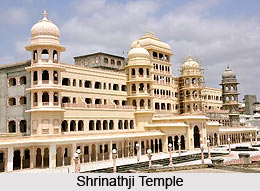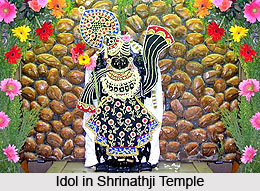 Shrinathji Temple is one of the most revered shrines of Lord Krishna. Located 48kms north of the beautiful city of Udaipur, in Rajasthan, the Shrinathji Temple is dedicated to Lord Krishna. The temple houses a beautiful black idol of Lord Krishna, sculptured from a single piece of black marble. The temple is exactly situated at Nathdwara. Nathdwara is small town that is truly famous for this temple. It belongs to the Vaishnav religion. The serene and beautiful landscape of Udaipur welcomes thousands of tourists and pilgrims every year from every nook and corner of the world.
Shrinathji Temple is one of the most revered shrines of Lord Krishna. Located 48kms north of the beautiful city of Udaipur, in Rajasthan, the Shrinathji Temple is dedicated to Lord Krishna. The temple houses a beautiful black idol of Lord Krishna, sculptured from a single piece of black marble. The temple is exactly situated at Nathdwara. Nathdwara is small town that is truly famous for this temple. It belongs to the Vaishnav religion. The serene and beautiful landscape of Udaipur welcomes thousands of tourists and pilgrims every year from every nook and corner of the world.
Shrinathji Temple is one amongst the richest temples of India. It receives millions of rupees as offering to the Lord. The temple authorities possess approximately 500 cows and the milk of these cows, is used for the preparation of sweets and milk products. Among these cows, there is one cow that is considered as "Shrinathji"s cow". This cow is believed to have come from the lineage, which served the Lord from ages. In this temple worship or `Puja` is replaced by servitude or `seva`. The temple priest changes the vestments and ornaments of Lord Krishna every day with love and reverence.
Etymology of Shrinathji Temple
Built in the 17th century, Shrinathji Temple is dedicated to Lord Shrinathji. "Haveli of Shrinathji" is the other name used for Shrinathji Temple. The word "Nathdwara" is made up of two terms, one being "Nath" that means "The Lord" and the other is "Dwara", which suggests "gate". Thus, Nathdwara implies the "gate of the lord". Shrinathji forms an important pilgrimage site for the Vaishnavites.
History of Shrinathji Temple
It is believed that the ruler of Mewar enshrined this unique idol of Lord Krishna. During the reign of the Mughal Emperor Aurangzeb in the 17th Century, Goswami Daoji brought the image of Lord Krishna from Mathura. At Shrinathji was then enshrined with complete Vedic rites and tradition.
It is believed that when the idol was being transferred to an unapproachable place, the wheel of the cart sank deep down in the mud at a particular place. The escorting priest perceived that this place has been chosen by the Lord himself. Consequently, the temple was constructed on the same spot.
Idol of Shrinathji Temple
The striking idol of Shrinathji gets the major attraction and is actually worth seeing. Shrinathji represents the form of Lord Krishna, when he raised the `Govardhan`, a hill. The image gives the impression of holding the Govardhan Hill in one arm. The other arm is shown resting on the waist.
 It denotes a dance posture and also symbolizes God blessing the devotees. Made out in black stone with images of two cows, one lion, one snake, two peacocks and one parrot engraved on it and three sages are placed near it. The Lord`s chin is adorned with a dazzling diamond, which is visible from a distance.
It denotes a dance posture and also symbolizes God blessing the devotees. Made out in black stone with images of two cows, one lion, one snake, two peacocks and one parrot engraved on it and three sages are placed near it. The Lord`s chin is adorned with a dazzling diamond, which is visible from a distance.
Architecture of Shrinathji Temple
The temple is built in simple terms of architecture, yet the divine aura of this temple is eternal. Structurally, a kalasha on the Shikhara marks the top of the temple, on which 7 flags are flown along with the Sudarshan Chakra. The flags represent the 7 "houses of Pushti Marg or Vallabh Sampradaya".
The huge temple complex is divided into many sections, like the main shrine, food, Prasad, Priests` lodges and stitching department, where tailors stitch marvellous dresses of Shrinathji. Like a regular household it has a chariot for movement (in fact the original chariot in which Shrinathji was brought), a store room for milk "Doodhghar", a store room for betel "Paanghar", a store room for sugar and sweetmeats "Mishrighar" and "Pedaghar", a store room for flowers "Phoolghar", a functional kitchen "Rasoighar", a jewellery chamber "Gahnaghar", a treasury "Kharcha Bhandaar", a stable for horses of chariot "Ashvashala" and a drawing room "Baithak". The temple has food-grinders made of gold and silver. It is also said to have four wells of `Desi Ghee`. In addition to these are the Shakghar and the outlets beautifully adorned with roses and betel leaves. The garden too is unique in its beauty.
There are three entrances in the temple. The first entrance is through the red door at "Chaupati". The Govardhan worship place can be reached from here. There are two other entrances. One entrance named "Surajpol" is entirely for women. It leads to "Kamal Chowk" through "Singhpol". The places worth seeing in the temple are:
•Moti Mahal
•Sudarshan Chakraraj
•Dhwajaji
•Kamal Chowk
•Ratan Chowk
•Mani Kotha
•Temples of Shri Navnit Priyaji
Festivals at Shrinathji Temple
During the festivities of Holi, Diwali, Phool Dei and Janmashtami, devotees come in large numbers. Besides these, Annakoot is a major festival that is observed here with a whole-hearted passion. On this occasion, cooked rice is hurled at the devotees after the ceremony and is `looted` by them. Non-Hindus are also allowed to visit this temple, however with the exception of foreigners. Undoubtedly, Shrinathji Temple is a place worth-visiting and feeling the spiritual delight.
Route to Shrinathji Temple
Udaipur is well-connected to the major cities of the country by road, rail and air. From Udaipur, one can take regular buses or hire taxis in order to reach Nathdwara.











